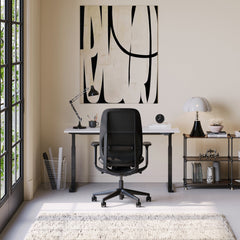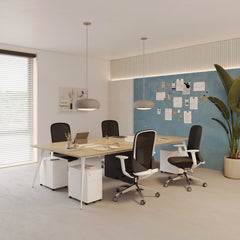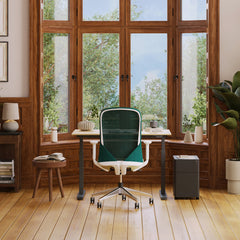Get 10% off your first order
Find the office furniture that’s designed to match your style, comfort, and needs perfectly. Subscribe
Beyond Desks and Chairs: How Cohesive Design Shapes Your Office Brand

Visit quiz page to see how we makes it easy to create an inspiring workplace

Small homes have become creative laboratories for functionality. As remote work continues to merge with home-based entertainment, a single room often serves as both an office and a personal retreat. This duality creates new demands for furniture that can perform on multiple fronts. A growing number of people are replacing bulky gaming chairs or stiff office seating with hybrid models that bridge comfort, versatility, and spatial efficiency.
The shift reflects a change in how we define comfort. It is no longer about plushness or aesthetics alone; it is about adaptability. Hybrid seating allows individuals to transition seamlessly between work and leisure without rearranging their entire space. In compact apartments and studio layouts, every inch counts, making a multifunctional chair a cornerstone of comfort and productivity.

Before the rise of hybrid living, chairs had distinct categories. Office chairs emphasized structure and ergonomics, while gaming chairs prioritized bold aesthetics and cushioning. However, the modern small home requires an integrated solution that performs in both domains. The pandemic accelerated this convergence, revealing the need for a single, adaptable seating experience that supports long hours of focused work and immersive play.
Traditional gaming chairs tend to be visually imposing and consume excessive space. Hybrid chairs, on the other hand, incorporate minimalist frames, neutral color palettes, and fluid forms that complement smaller interiors. These designs balance posture support with a sense of openness, creating a visual harmony that helps rooms feel uncluttered.
Hybrid seating thrives on subtlety and intention. The ergonomic chair built for hybrid work exemplifies this balance with its clean lines, adjustable mechanics, and breathable materials. It delivers ergonomic alignment without overwhelming the visual composition of a compact room. Hybrid chairs often feature slim backrests, smooth recline functions, and textures that align with both modern workspaces and leisure settings. Their design language invites users to remain comfortable and engaged throughout the day, blending performance and aesthetic restraint.
Ergonomics is the foundation of a quality hybrid chair. Every angle and adjustment is designed to promote healthy posture and support the natural curvature of the spine. A well-constructed hybrid model uses a contoured seat to distribute pressure evenly, reducing tension in the lower back and shoulders. Breathable fabrics regulate temperature during long sessions, while smooth-rolling casters preserve mobility in confined areas.
Not all ergonomic features are equal. Adjustable seat depth allows for precise leg support, while dynamic armrests adapt to different work and gaming positions. Tilt tension and recline locks enhance stability when shifting between active and relaxed modes. The custom-fit Muse chair for compact work setups demonstrates how individual adjustability empowers comfort without requiring additional accessories or bulky attachments.
A chair that promotes healthy posture is not a luxury; it is essential for long-term wellness. According to the CDC’s ergonomic principles for workspace safety, maintaining a neutral spine and balanced alignment can help reduce musculoskeletal strain and fatigue. Chairs designed with ergonomic accuracy encourage better focus and energy retention across long sessions, minimizing the need for frequent breaks or postural adjustments.
Hybrid seating encourages small, natural shifts in position. These micro-movements keep circulation flowing and muscles active, especially during extended work or play periods. Active sitting supports cognitive alertness and prevents stiffness, ensuring that comfort does not come at the cost of mobility.
Selecting the right hybrid chair involves balancing form, function, and space efficiency. Compact living does not have to compromise on performance or aesthetics.
| Model | Design Focus | Best For | Key Advantage |
|---|---|---|---|
| adjustable mesh chair for dual-purpose rooms | Breathable and dynamic structure | Long hybrid sessions | Continuous airflow and balanced spinal support |
| modern sculpted chair for minimalist interiors | Compact, lightweight design | Design-conscious users | Seamless comfort with visual elegance |
| soft-fabric ergonomic chair for daily use | Plush upholstery with adaptive frame | Work-from-home professionals | Balanced posture with lasting comfort |
The choice of materials influences both comfort and longevity. Mesh enhances ventilation and maintains structural integrity without excess padding, while fabric offers warmth and softness suited for all-day use. Synthetic blends improve cleanability, which is particularly beneficial for smaller spaces where furniture is used intensively.
Hybrid chairs now serve as design statements as much as functional tools. Their minimalist silhouettes complement streamlined interiors, and neutral colors integrate easily with diverse décor styles. These details matter in small homes, where visual simplicity supports mental clarity and a sense of spaciousness.
In limited square footage, spatial flow determines usability. Placing a chair near natural light sources reduces eye strain, while corner-oriented desks open up central floor areas. Smart zoning with rugs, lighting, or partition shelving helps define boundaries between work and relaxation.
A cohesive setup begins with proportional furniture. The compact desks for hybrid setups integrate with ergonomic seating to create harmony between chair height and desktop level. Proper alignment ensures wrists, elbows, and shoulders remain balanced, improving overall posture and reducing fatigue.
Personalization enhances functionality in small homes. Modular layouts and stackable accessories enable flexibility without clutter. The personalized furniture bundles for ergonomic optimization concept allows homeowners to design complementary setups that evolve with their lifestyle, merging comfort and adaptability.
Sustainability is no longer an afterthought; it is a defining element of quality design. Chairs crafted with recycled metals, responsibly sourced wood, and non-toxic fabrics reduce environmental impact while maintaining durability. These materials align with the mindful approach to consumption often embraced by small-home dwellers.
Consistency in furniture design helps unify a space. Selecting pieces from the Urbanica chairs collection for modern homes ensures visual balance and style continuity. Shared textures, hues, and proportions create an effortless flow from workspace to leisure zone, turning compact areas into curated environments rather than cramped necessities.
Choosing the right hybrid chair begins with an honest evaluation of daily habits. Users who alternate frequently between meetings and gaming need adaptive back support and flexible recline, while those with fixed tasks benefit from firmer structures. A hybrid model provides both comfort and precision, adjusting to different postures without requiring multiple pieces of furniture.
Accurate measurements prevent overcrowding and enhance usability. Allowing sufficient clearance behind the chair maintains fluid motion, while slim-framed designs create an illusion of openness. Transparent or mesh materials further amplify light and spatial depth, keeping compact environments airy and inviting.
Adjustable lumbar support to match spinal curvature
Swivel base for smooth repositioning
Reliable weight capacity and supportive frame integrity
Breathable, easy-to-maintain fabric
Seamless compatibility with desk height and layout

The hybrid chair symbolizes more than convenience; it represents the fusion of comfort, design intelligence, and adaptability. As homes continue to serve multiple roles, seating will evolve to meet changing rhythms of work and recreation. Emerging innovations focus on intuitive ergonomics and materials that adapt to human behavior rather than imposing rigid forms.
In small homes, a single well-designed hybrid chair can anchor both functionality and style. It supports focus during work hours and invites relaxation after them. Hybrid seating demonstrates that comfort does not require excess—only thoughtful design, honest craftsmanship, and an appreciation for the balance between human needs and limited space.

Beyond Desks and Chairs: How Cohesive Design Shapes Your Office Brand

The Silent Energy Drain: Designing Tables and Chairs That Fight Work Fatigue

The Performance Equation: Unlocking Employee Potential with Ergonomic Design
Get 10% off your first order
Find the office furniture that’s designed to match your style, comfort, and needs perfectly. Subscribe
Leave a comment